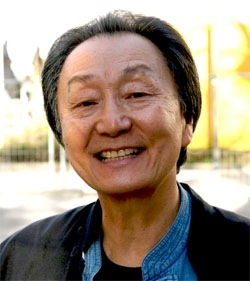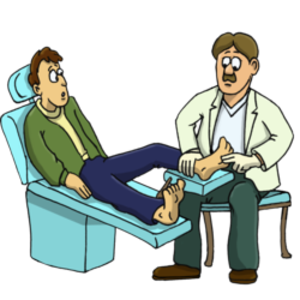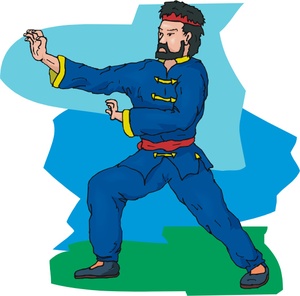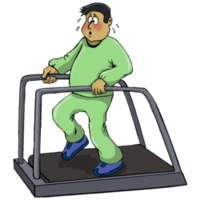Caring For Your Body

“Many people treat their bodies as if they were something rented from Hertz: something they are using to get around in but nothing they genuinely care about understanding.”
–Chungliang Al Huang (Chinese T’ai Chi Ch’uan Expert, Calligrapher, Author and Founder of the Living Tao Foundation, 1937-)
Yielding

The first and last lesson of t’ai chi ch’uan is to yield and yield again. And in the West:
“Oaks may fall when reeds stand the storm.”
–Thomas Fuller, M.D. (English Physician, Intellectual and Preacher, 1654-1734)

T’ai Ch Ch’uan and Your Feet

One of the worries about getting older is that aging can adversely affect our balance and increases the chance that we can slip and fall. This is even more of a problem in people with loss of sensation in the soles of the feet due to diabetic peripheral neuropathy and other diseases. T’ai Chi Ch’uan has previously been shown to improve balance in healthy elderly adults.
A new study from the Biomedical Engineering Program, Milwaukee School of Engineering, Milwaukee, Wisconsin was just published in the journal Diabetes Technology and Therapeutics.
The aim of the study was to see if T’ai Chi improved both balance and sensory perception in the soles of the feet in healthy elderly adults and elderly adults with diabetes and sensory loss in the feet. Eighteen elderly people with a mean age of 73.1 years were tested for sensation and balance before t’ai chi training and again after 6 months of weekly sessions. Participants were grouped by their initial scores on tests of sensory perception, in order to calculate the effects of t’ai chi on sensory perception.
Plantar (soles of feet) sensation results showed that all the participants showed significant improvement in sensory ability with the 6 months of t’ai chi training. All groups also had a general improvement in all balance measures, with the greatest improvement seen in those subjects with large sensory losses. Hemoglobin A1c measurements – a standard way of estimating control of blood glucose – also decreased as a result of the intervention.
The study was small, but the effectiveness of t’ai chi training as a method of improving plantar sensation and balance in elderly adults with sensory loss, with and without diabetes, was impressive.
Another one of those things that is supposed to be impossible!
T'ai Chi Ch'uan and Shingles

Shingles can be a particularly nasty problem, and treatment can be tough. It should be called herpes zoster, and it is caused by re-activation of varicella zoster virus (VZV) that causes chickenpox.
A new study from the Norman Cousins Center for Psychoneuroimmunology at UCLA, has shown that t’ai chi therapy can stimulate the immune system of patients with shingles to levels comparable to those achieved using a vaccine against VZV.
It was a controlled trial in which the researchers randomized 112 healthy adults aged 59 to 86, who had a history of varicella infection, to Tai Chi Chih (TCC, a simplified, standardized form of tai chi) or health education (HE) for 25 weeks. After 16 weeks of intervention, subjects were vaccinated against VZV. The results of blood tests showed that TCC alone increased immunity against VZV by an amount comparable to that induced by varicella vaccine in the HE group.
It was interesting that the effects of the two were additive; TCC, together with varicella vaccine, produced a substantially higher level of immunity against VZV than vaccine alone, raising it to levels usually observed in adults 30 years younger.
The tai chi group also showed significant improvements in scores for physical functioning, bodily pain, vitality, and mental health.
Regular readers will recall another report from this research group, indicating that TCC reduced the activity of the sympathetic nervous system. The two studies both show that there is something special going on: the practice does not only calm the mind and body, it also regulates parts of the body that are normally beyond voluntary control.
There are clearly plenty of reasons for taking up t’ai chi, though now we shall have to see whether other forms of t’ai chi can achieve the same results.
T’ai Chi Chih and the Sympathetic Nervous System

One of the problems about getting older is that the activity of the sympathetic nervous system may increase, bringing with it an increased risk of metabolic problems such as insulin resistance, hypertension and cardiovascular disease.
The sympathetic nervous system is a branch of the autonomic nervous system. It is always active at a basal level, which is called sympathetic tone. It becomes more active during times of stress. Its actions during the stress response comprise the classical fight-or-flight response.
There is a very interesting study from the Norman Cousins Center for Psychoneuroimmunology at the UCLA Semel Institute for Neuroscience & Human Behavior in Los Angeles.
There were 32 people in the study aged 60 or over. There were 19 people who were T’ai Chi Chih (TCC) practitioners and 13 who were not. The practitioners had completed a 25-week training in TCC the 13 others just had health education classes. T’ai Chi Chih is a simplified type of T’ai Chi that emphasizes the development of qi, a.k.a. chi.
TCC practitioners performed the breathing and movements for 20 minutes, while HE participants passively rested for the same time. Investigators measured various cardiovascular parameters before and after the task. A subsample of participants returned for a second evaluation and performed videotape-guided stretching for 20 minutes to evaluate the cardiovascular effects of slow-moving physical activity. TCC performance was found to significantly decrease sympathetic nervous system activity as measured by cardiac pre-ejection, blood pressure and heart rate. In contrast, there was no change in sympathetic activity following passive rest or slow-moving physical activity.
This shows us that there is something different about T’ai Chi. Practicing it leads to a decrease in activity of the sympathetic nervous system to levels that are not achieved by performing comparable physical activity alone.
T’ai Chi Ch’uan and Diabetic Health

Regular readers will know that I am a great fan of t’ai chi ch’uan and qigong. I have been recommending them to people for years and even taught it for a while.
I have also been very interested in metabolic problems, particularly insulin resistance and diabetes.
So I was intrigued to see a study from Taiwan that was just sent to me.
The trial involved thirty-two people with type 2 diabetes mellitus who participated in three hour-long tai chi sessions once a week for 12 weeks. The conclusions were that practicing t’ai chi might help improve one component of immune function and also improve the control of blood glucose.
The researchers found statistically significant reductions in levels of glycosylated (glycated) hemoglobin in the blood of participants, indicating improved long-term blood glucose control. Glycosylated hemoglobin or HbA1c reflects the average blood glucose over the last 8-12 weeks, implying that the improvement must have been quite swift.
They also found increased numbers of regulatory and killer T cells. This may be important: people with diabetes are at considerably increased risk of getting infections.
It is even more impressive that the study was published in the journal Diabetes Care, that is known for its exacting standards.
If you or a loved one has diabetes, you may want to think about taking up t’ai chi.
Good luck!
Non-pharmacological and Lifestyle Approaches to Attention-Deficit/Hyperactivity Disorder: 11. Integrated Medicine

The whole point of Integrated Medicine and Integrated Health is to help the person with attention-deficit hyperactivity disorder (ADHD) to become integrated as a person by using an integrated approach to treatment. This kind of comprehensive approach is particularly important for many people with ADHD. I also want to re-emphasize that although ADHD is the approved term for the problem, many people, particularly adults, may have little overt evidence of hyperactivity, and they are better thought of as having “ADD.”
Attentional problems come in all shapes and sizes. Some are so mild that people just need to be shown how to use a day planner and implement some time management scheme. Others need a more aggressive and comprehensive approach. Whatever we do has to be individualized to the person with the problem. Not only do we have to match the plan with the person, we also need to match it with his or her belief system.
It is important to recognize that no one approach is likely to work on its own. Medications may be very helpful, but they are only tools to help people get organized so that they can fulfill their potential. And medications are unlikely to be effective unless we also deal with nutrition, posture, breathing, sleep and environmental stress.
It is also essential to realize that ADHD is highly co-morbid: there is evidence of increased rates of physical problems, including disturbances in thyroid function and cell membrane function throughout the body. The rates of conduct disorder, oppositional defiant disorder, learning disabilities, tics and Tourette’s, worry, anxiety and mood disorders are all much higher in people with ADHD. So high that until recently, many experts believed that ADHD was a symptom rather than a clearly delineated illness. This overlap is also one of the reasons why some people persist in saying that the diagnosis of ADHD is nothing more than a stigmatizing label for socially unacceptable behavior.
Physical
- Medications
- Nutrition
- Posture
- Exercise
- Environment
Over the last few weeks we have spent a lot of time looking at some of the options for treating the physical components of the problem. Now let us look at the rest.
Psychological
- Find out and work with a person’s interests. ADHD is highly dependent on context. A child or adult may have terrible problems with schoolwork, but be able to play a video game for hours on end
- There are multiple intelligences: uncover which are of the greatest importance. It is essential for a person to discover their strengths rather than being forced to focus on the weaknesses. Many people with ADHD find that highlighting text in a book can be useful, while others learn by doing
- People are more likely to follow instructions if they are interesting and emotionally charged
- Bear in mind that many people have poor self-esteem and others suffer from enormous feelings of regret. This is a particular issue for people who may have reached middle age before being diagnosed. We have seen countless people who feel that they have missed out on life. A man working in construction realized that he could have gone to college thirty years ago if only his ADHD had been diagnosed and treated
- Teach visualization skills
- Discover which times of the day are best in terms of attention and alertness
- Learn some simple relaxation techniques
- Learn problem-solving skills
Social
- ADHD can play havoc with relationships. If a child has it, there can be enormous stress on the parents and siblings, all of whom are at higher risk of some features of ADHD themselves. It is essential to help the family with coping skills. ADHD can also put a great deal of stress on a spouse or children. It is also important to know that many people with ADHD have sexual problems that stem from impatience, a low frustration threshold if they cannot have sex when they want it, and real problems with enjoying the moment and taking time to enjoy a romantic interlude. Some people also use sex as a form of self-medication. So it is essential to find out if there are sex or relationship problems and to deal with them, which may need outside help
- Many people with ADHD are socially awkward and may need to learn some social and communication skills
- ADHD and social awkwardness can be magnets for bullies, and it is remarkable how many young people with untreated or inadequately treated ADHD have been bullied. Occasionally they become the perpetrators of bullying to compensate for their difficulties. In either case it is important to discover and deal with bullying. It is one of several reasons why some experts have recommended enrolling a child in martial arts classes. Not only can they help with self-defense, but also the discipline of a martial arts class can work wonders for some people with ADHD
- Role models are important for people with ADHD. It is very helpful, particularly for young people to see that other sufferers have become extremely successful
- It is also important for parents and other family members to develop and maintain a positive image of the person with ADHD
- Develop positive yet realistic career and life goals
Subtle
- Poor breathing techniques can engender many problems. Learning to breath effectively can have profound physical effects as well as stimulating and balancing the subtle systems of the body
- As we have seen, although the research base is very small, yoga, t’ai chi ch’uan or qigong can all be very helpful
- Many people with ADHD are acutely sensitive to “atmosphere:” to the thoughts, feelings and attitudes of other people, and they need specific help to remain grounded and to protect their senses. Some of the flower essences can very helpful for that, as well as some other techniques that we shall be publishing shortly
Spiritual
- How can there be a spiritual component to ADHD? Some people find it difficult to engage in prayer or meditation because of problems with attention. However, with a little perseverance, we have evidence that some forms of meditation may actually help.
- Second the rituals of religion can sometimes provide a wonderful anchor for the person who is having a had time with ADHD.
- Another point is that ADHD is not all bad. Some people who have it become more attuned to nature, animals and to a mystical understanding of the world: an over-reliance on reasoning and linear learning can stifle those perceptions.
- Some people have suggested that ADHD may for the same reasons unlock a rich vein of creativity that might otherwise never have appeared.
There are plenty of books and websites that portray ADHD as a gift. While I have the greatest respect for this approach, it is still important for us not to forget the demonstrable problems caused by inadequately treated ADHD.
ADHD exists, it is treatable, and though it can bring many problems, it can also bring many opportunities. Just so long as we remember to respect every dimension of the person who has it, and remember that if we do not manage it, it will manage us.
Non-pharmacological and Lifestyle Approaches to Attention-Deficit/Hyperactivity Disorder: 7. Yoga, Meditation and T’ai Chi Ch’uan

It may seem strange that someone with an attentional problem could sit still long enough to do yoga or meditation, but here is some evidence that they can do them and derive long term benefit.
Yoga
There are hundreds of different types of yoga, but the one that has been examined the most is hatha yoga. The first report of an improvement in ADHD symptoms with relaxation training including a yoga component was published in 1992. There is a small peer-reviewed study of yoga for children with ADHD. It was a six-week open trial of twice weekly hatha yoga lesson for both parents and children. The participants were also encouraged to practice at home. At the end of the six weeks, there were subjective improvements in behavior, and in those who practiced at home there was an improvement in emotional lability.
Another pilot study this time from Heidelberg in Germany suggested that yoga can be an effective complementary or concomitant treatment for ADHD. That was also the conclusion from a recent review article: yoga, like most of the other complementary methods of treatment, may be a good adjunct, but we do not have enough evidence to use it in place of existing treatments.
That being said, many experts and many yoga teachers consistently report that they have students who have improved very markedly when they follow a regular yoga regimen.
Meditation
Eugene Arnold’s excellent review of unorthodox treatments for ADHD cites two studies from the 1980s that showed significant improvements in the behavior of children who were taught to practice meditation. (Kratter J. The use of meditation in the treatment of attention deficit disorder with hyperactivity. Dissertation Abstracts International 1983;44:1965 and Moretti-Altuna G. The effects of meditation versus medication in the treatment of attention deficit disorder with hyperactivity. Dissertation Abstracts International 1987;47:4658.) Neither of the reports is easily available and the studies were not published in peer-reviews journals. A small six-week pilot study using Sahaja Yoga meditation for children with ADHD and their families reported a small but useful benefit.
Although there is not much published research on the use of meditation and ADHD, there are a great many anecdotal reports, and some good theoretical reasons for thinking that it should help. Research has shown that expert meditators produce both structural and functional changes in their brains, particularly in the regions involved in attention.
T’ai Chi Ch’uan
There are a large number of reports of people with ADHD improving if they practice t’ai chi or qigong, and in the days that I taught them, I have seen some remarkable improvements. But sadly there are few peer-reviewed studies in any of the languages that I can read.
There is a small but interesting study that was published in the Journal of Bodywork & Movement Therapies and involved 13 adolescents with an average age of 14.5 years. They were taught some basic t’ai chi moves for 30 minutes twice a week for five weeks. The sessions consisted of breathing exercises accompanied by slow raising and lowering of the arms, twisting and turning of the arms and legs, shifting body weight, rotating and changing direction.
The researchers used the 28-item Connors’ Teacher Rating Scale was used to evaluate their behavior prior to the tai chi classes, during the classes and two weeks after the classes ended. The adolescents’ teachers perceived them as less anxious, emotional and hyperactive. These improved scores remained consistent throughout the two-week follow-up period.
Given the anecdotal reports of the benefit of t’ai chi ch’uan and qigong on attention, concentration, depression and anxiety, it is important to do some more research on them n ADHD. In the meantime, there is no known downside of someone with ADHD using these practices in combination with more orthodox approaches.
And if they help, I would like to hear about it!
World T'ai Chi & Qigong Day

It seems incredible that a year has passed since I last wished everyone a Happy World T’ai Chi & Qigong Day, which falls this year on April 28th.
At 10 a.m. local time, wherever you are in the world, there will be what they describe as, “A global health and healing event that will be held in hundreds of cities in sixty nations. Free and open to the public these events welcome anyone interested in personal and global health and healing.”
The aim is to send a wave of positive healing “energy” around the world and draw attention to the benefits of T’ai Chi and Qigong.
You can visit can visit http://www.worldtaichiday.org to find events being held in your area that will be offering free teach-ins and exhibitions.
If you look on the left-hand side of the website under “Everyone’s Resources” you will find a great many extra resources, primarily related to T’ai Chi and Qigong and health, including a list of much of the research that has been done. It is just a list of papers and their summaries, but is a good place to start if you are not a specialist. There are also lists of places where you can learn T’ai Chi.
In my view, learning the basics of T’ai Chi and Qigong from a competent teacher is one of the best investments that you can ever make in yourself.
Now to that picture at the top of this article. It is not a hoax! You can find it at the Taichi Heartwork website.
I have had the privilege of studying T’ai Chi and Qigong with eight superb teachers on three continents. I learned a very great deal from each of them. The one who really resonated with me was Grandmaster John Kells, an Irishman who was a disciple and adopted son of Dr. Chi Chiang Tao.
John introduced more than 10,000 people to these arts, and many of them saw him demonstrate his internal force by throwing people without any physical contact. I have experienced it myself many times, and it is very real.
It is a by-product of personal development and a great deal more than a party trick. Very few of the Masters that I have known have developed themselves this far. If you get the chance to meet one, it can be life-changing.
For years now various scientists have claimed to have made machines that can generate this kind of force. So far I have not been convinced, despite having traveled to China, Russia and a dozen other countries to look at some of these gadgets.
If I find one that works, I shall let you know.
Until then, consider developing your own Qi. (It’s sometimes spelled Chi or Ki). Next Saturday may be just the excuse that you need!
Exercise Beats "Dieting" in Managing Obesity

An important report was presented at the Scientific Meeting of the United Kingdom Society for Behavioural Medicine in Cambridge earlier this month.
A team of researchers from Leeds Metropolitan University and the University of Hull studied 62 women aged 24 to 55. They all had a Body Mass Index (BMI) over 30, which is classed as clinically obese. (Regular readers will know that most experts have moved away from using BMI to evaluate metabolic and cardiovascular risks).
The program encouraged women not to diet but to take part in exercise classes. They were required to do four hours a week of exercise, such as t’ai chi, aqua aerobics or circuit classes. So it was not necessary to become a hard core exercise freak!
The researchers found significant improvements in health and mental well-being.
The women in the study were also taught about good eating habits, including how to read food labels and cook food, and they received social support and behavioral therapy to help them respond to body cues such as hunger and feeling full.
After a year, the women had only lost a little weight but were significantly fitter and happier with themselves. Their blood pressure, heart rate and cholesterol fell and respiratory fitness increased. And the women also felt better in terms of general well-being, body image, self-perception and stress.
This small, simple study re-emphasizes what we have said to tens of thousands of people: fad diets will only help in the short term. For all practical purposes you can eat what you want, but in moderation. But try gradually to change the composition of your diet. I have written some advice on doing that. In Healing, Meaning and Purpose we also provide a number of tactics to help you tackle some of the psychological and social hurdles that may stand in the way of weight management. Which include something not often discussed: the twelve ego-fears that can be the hidden drivers to a lot of our behavior.
Understand them and you can gain a remarkable degree of control of your thinking and your emotions.
And it is exercise that should be the centerpiece of a weight management strategy.
This was re-inforced by a study published last week in the Archives of Internal Medicine: people who lost weight by restricting calories lost bone mineral density. Those with exercise-induced weight loss did not.
And as you doubtless know, loss of bone mineral density is one of the key risk factors for osteoporosis.
So please don’t buy in to some new “miracle” diets: they simply don’t exist.
Instead:
- Gradually increase your level of exercise
- Slowly change the composition of your diet
- Keep your internal organs – especially your intestine – in balance
- Develop your food awareness (I am going to do a whole post/article about that!)
- Learn how to deal with the psychological, social subtle and spiritual aspects of suboptimal eating (Check out the reources that I have already provided + a new eBook in the New Year)
And before you know it, you will be exactly where you want to be.
Promise!
Lack of activity destroys the good condition of every human being, while movement and methodical physical exercise save it and preserve it.”
–Plato (Athenian Philosopher, 428-348 B.C.E.)
“The way to cheerfulness is to keep our bodies in exercise and our minds at ease.”
–Sir Richard Steele (English Dramatist and Essayist, 1672-1729)






